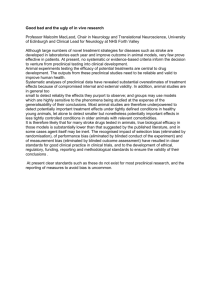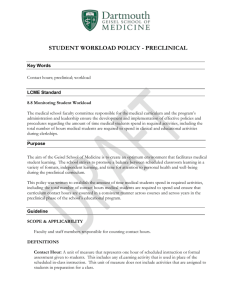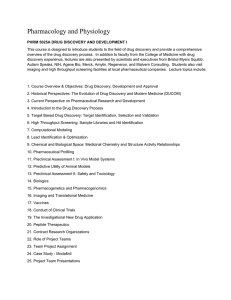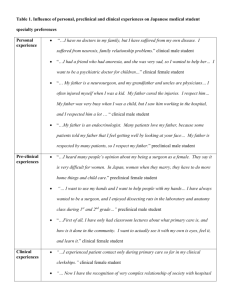Prospective survey of performance preclinical years
advertisement
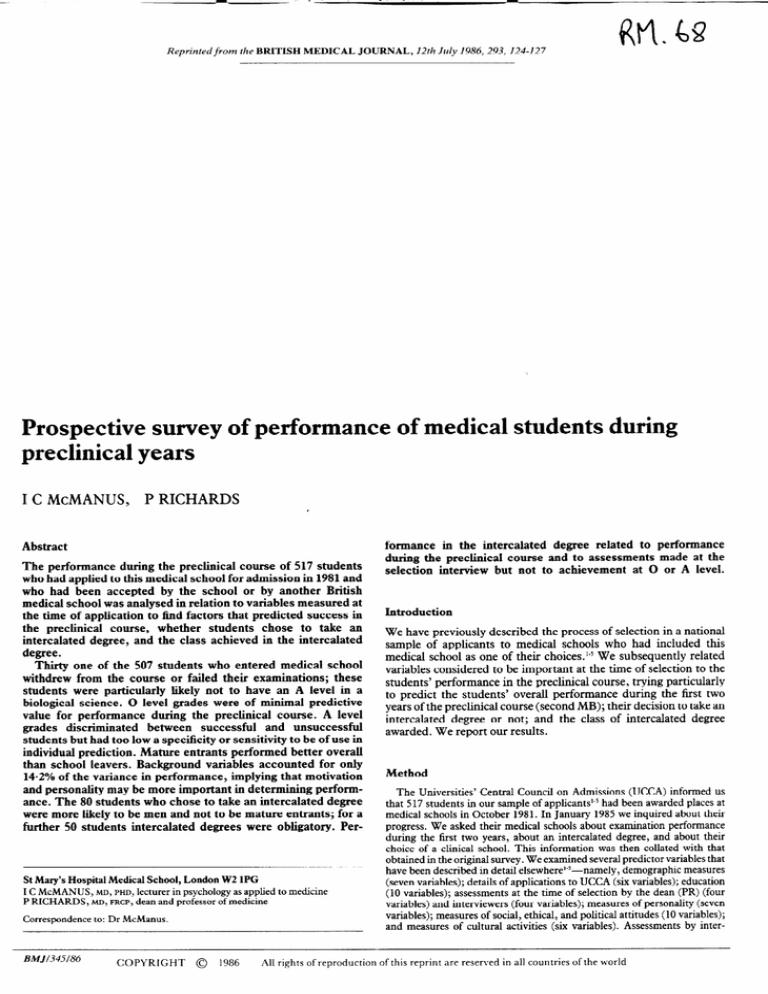
Reprintedfrom the BRITISH MEDICAL JOURNAL, Prospective survey of performance preclinical years I C McMANUS, 124127 of medical students during P RICHARDS Abstract The performance during the precliuical course of 517 students who had applied to this medical school for admission in 1981 and who had been accepted by the school or by another British medical school was analysed in relation to variables measured at the time of application to find factors that predicted success in the preclinical course, whether students chose to take an intercalated degree, and the class achieved in the intercalated degree. Thirty one of the 507 students who entered medical school withdrew from the course or failed their examinations; these students were particularly likely not to have an A level in a biological science. 0 level grades were of minimal predictive value for performance during the preclinical course. A level grades discriminated between successful and unsuccessful students but had too low a specificity or sensitivity to be of use in individual prediction. Mature entrants performed better overall than school leavers. Background variables accounted for only 14.2% of the variance in performance, implying that motivation and personality may be more important in determining performance. The 80 students who chose to take an intercalated degree were more Likely to be men and not to be mature entrants; for a further 50 students intercalated degrees were obligatory. Per- St Mary’s Hospital Medical School, London W2 1PG I C McMANUS, MD, PHD, lecturer in psychology as applied to medicine P RICHARDS, MD, FRCP, dean and professor of medicine Correspondence to: Dr McManus. BMJl34.5186 12th July 2986,293, COPYRIGHT 0 1986 All rights of reproduction formance in the intercalated degree related to performance during the preclinical course and to assessments made at the selection interview but not to achievement at 0 or A level. Introduction We have previously described the process of selection in a national sample of applicants to medical schools who had included this medical school as one of their choices.1-5We subsequently related variables considered to be important at the time of selection to the students’ performance in the preclinical course, trying particularly to predict the students’ overall performance during the first two years of the preclinical course (second MB); their decision to take an intercalated degree or not; and the class of intercalated degree awarded. We report our results. Method The Universities’ Central Council on Admissions (UCCA) informed us that 5 17 students in our sample of applicants’-5 had been awarded places at medical schools in October 1981. In January 1985 we inquired about their progress. We asked their medical schools about examination performance during the first two years, about an intercalated degree, and about their choice of a clinical school. This information was then collated with that obtained in the original survey. We examined several predictor variables that have been described in detail elsewhere’-s-namely, demographic measures (seven variables); details of applications to UCCA (six variables); education (10 variables); assessments at the time of selection by the dean (PR) (four variables) and interviewers (four variables); measures of personality (seven variables); measures of social, ethical, and political attitudes (10 variables); and measures of cultural activities (six variables). Assessments by inter- of this reprint are reserved in all countries of the world BRITISH 125 viewers and measures of personality, attitudes, and culture were available only for the 248 entrants who had been interviewed at this medical school. Statistical analysis was by means of the SPSS-X and GLIM program suites.“’ Multivariate analysis consisted of multiple regression and multiple logistic regression, backward elimination of variables being used in each case until all remaining variables were significant at the prespecified level of O-05. In multivariate analyses the missing values in independent variables were replaced by their means and a dummy variable was included to indicate the presence or absence of missing data, as recommended by Cohen and Cohen.” The standardised likelihood ratio in multiple logistic regression was calculated by dividing the regression coefficient by the standard deviation of the measure and then using exponentiation and may be interpreted as the change in likelihood for a change of one standard deviation in the predictor. MEDICAL JOURNAL Overall perfnmunce during preclinical course-Overall performance in the first two years of the preclinical course was graded by giving a score of one for an outright fail, two for an unsatisfactory performance, three for a satisfactory performance, and four for a distinction. Multiple regression of this score on the background variables found six variables that produced a significant prediction, with a multi+e correlation of O-377, accounting for 14.2% of the total variance (table II). -More successful students had higher A level and higher 0 level grades, had taken a biology A level, were more likely to be women and to be mature entrants, and to have come from smaller secondary schools. Figure 1 shows the mean or proportion of each of these variables in the four separateclassesof students. Biology A level distinguished outright failures from other groups, whereas mature entry and sex showed linear trends across the four groups. Mean performances at 0 and A level did not distinguish between outright failures and unsuccessful candidates. Results Completed proformas on entrants were received from all British medical schools. Altogether 484 of the 5 17 students had entered preclinical studies in October 1981 and a further 22 had deferred admission until October 1982, all but one at their original medical school. One student had been exempted from preclinical training. Of the 10 students who had not entered a medical school, two had withdrawn, one to a non-medical course and one to an unknown destination, and one had subsequently been found to have inadequate A levels; no information was available on the remaining seven students. A total of 502 students were required to take exams during their first year; 21 did not enter the second year of t,,eir course. A total of 485 students took exams during their second year. Table I shows the outcome of the exams in the first and second years. II-Multiple regression of overall success at second MB examination, with withdrawal or failure be@ scored as one, unsatisfactory performance as two, satisfactory as three, and dist&ction as four TABLE Regression coefficient Variable p Value 1: Average A level grade <O%lOOl 2: Biology A level taken 3: Sex <O+lOO1 4: Mature entrant 5: Average 0 level grade <om5 <0+05 <0+05 <o-o1 6: Overall size of secondary school I-Outcome for students at end of&t numbers (%) of students TABLE and second preclinu7alyears. First year Distinction, honours, prize, or first Pass without resitting any exam Pass after resitting one or more exams Pass after retaking year Withdrawal or failure: Failed after resitting exams Withdrawal after exam failure Withdrawal to nursing* Emigration* Death* 33 (7) 369(74) 72(14) 7 (1) Total 502 11 7 1 (4) Figures are Second year Simple correlation with overall success* 95% *Pearsonian A5 b=0.226 per average A level grade b=0.280 if taken ti=O.177 iffemale b=0.343 if mature b=0.222 per average 0 level grade b= -0.0210 per 100 pupils Confidence limits O-133,0.321 0.228 0.148,@412 O.lSO 0.166 o-061 0.054,0-300 0.133,0*533 0.079,0-364 -0.0051, 0.212 -0-0369 -0.098 correlation. Mathemabcs A 1 Students Hnth blologiml A led 47 (10) ,367(76) 54(11) 7 (1) ;f}(2) A level 1 1I 485 *Before taking exams. F U S D F U S D F U S D l-Mean overall grade at 0 and A level; mean grades attained in A level biology, physics, chemistry, and mathematics; and proportions of women, mature students, and students taking biological sciences at A level in four groups of students classKed according to performance during preclinical course. F = Failure or withdrawal. U = Unsatisfactory performance. S = Satisfactory. D = Distinguished. FIG On the basis of their results at the end of the first and second years we divided the students into four groups: withdrawals and failures comprised students who did not successfully complete the preclinical course (n= 3 1; 6% of entrants); unsatisfactory students comprised those who had to resit at least one examination during the preclinical course (n= l& 21%); satisfactory students comprised those who did not have to resit any examinations and who did not achieve distinction (n=312; 62%); and distinguished students comprised those who achieved honours, distinction, prizes, or first class marks during either of their first two years (n= 57; 11%). If students satisfied criteria for several groups they were placed in the lowest group for which they were eligible. Of the 475 students who proceeded beyond preclinical studies, 80 took an optional intercalated degree and a further 50 were at medical schools where an intercalated degree was an obligatory part of the course. The subjects in which intercalated degrees were taken were physiology (17 students), anatomy (16), biochemistry (13), pharmacology (13), psychology (12), pathology (nine), history of medicine (two), computing (one), law (one), anthropology (one), mixed subjects (four), and others (41). Of the 123 students for whom class marks were available, 23 had received a first, 69 an upper second, 19 a lower second, and 12 an unclassed second; none had received third class or pass degrees or had failed. When students who had received unclassed seconds were excluded the proportion of lower second class degrees was higher among those who had taken obligatory degrees (31%) than among those who had taken optional degrees (11%) (x2=7*4, 1 df, p<O.Ol). All students who took intercalated degrees went on to clinical courses except for four, who deferred clinical training to read for a higher research degree. Cumulative distributions of mean grades at 0 and A level in the four groups of entrants (fig 2) showed that no threshold or line of discrimination would produce a high degree of sensitivity and specificity for distinguishing between the four groups c: entrants. Each of the four major A level subjects (physics, chemistry, biology, and mathematics) showed the same broad pattern as the mean A level grade, with the exception of A level in mathematics, which particularly seemed to differentiate distinguished students from the rest (fig 1). Optional intercalated degree-Of the 425 students at schools where intercalated degrees were not obligatory, 80 bo+h wanted and were allowed to take intercalated degrees. Multiple logistic regression (including all the variables used above as well as overall performance in the second MB) found five significant predictors for students taking an optional intercalated degree (table III) -namely, higher performance at second MB; lower scores on attitudes to medical control (that is, less in favour of external control of the medical profession and hence more in favour of medical autonomy); more subjects taken at A level; not being a mature student; and being a man. Students taking intercalated degrees had higher average grades at A level (mean scores of 4.16 v 3.96, p<O.O25, t test), but this was not a si&cant predictor after performance at second MB had been taken into account. BRITISH MEDICAL rrr-Multzple take non-obligatory TABLE 126 JOURNAL logistic regression of factors predicting intercalated degrees whether students would Mean (SD) score for variable or % of students 95% Confidence limits Students who took a degree Students who did not take a degree Variable p Value 1: Performance at second MB 2: Attnude to medical control 3: Number of A levels taken 4: Mature applicant 5: Female student <O.OOOl 4.84x per scale item 2.89,X.09 3.22 <0.025 6-28x (standardised) 1.51,262 0.010 (0.43) 0.238 (0,43) ~0.025 2-00x perAleve1 l-16,3.45 3-265 (0.54) 3.161 (0.45) Likelihood <O.Ol 6-03x if not mature l-63,22.3 <0.05 0.53x if female 0.30,0.93 0 level (0.53) 2.87 3.75% overall assessments; and having lower scores on a measure of non-literary culture (which primarily assessed activity in music and the performing and visual arts) (fig 3). Together these variables gave a multiple correlation of 0.5 19, accounting for 26.9% of variance. Analysis without the inclusion of preclinical performance produced broadly similar results, all the four variables above being included at the O-05 level; in particular there was no evidence that either A or 0 level grades were significant predictors of the class of degree achieved (fig 3). (0.58) Perfwmance second MB Prevcous applicat Ion to -- at 10.8% 43.2% 37.5% A level 01 1 i 212 (i, il Class of degree i - Culture factor ‘non- lttemry culture” 2:2 ii) 2'1 i 3-Mean values of variables related to class of degree obtained by students taking intercalated degree (1 =first, 2: 1 =upper second, (2)=unclassed second, 2:2=lower second). Variables are: overall score in second MB examinations (unsatisfactory = 2, satisfactory= 3, distinction = 4); mean grade achieved at 0 and A level (A= 5, B=4, etc); proportion of students who had previously applied to UCCA; mean interviewers’ final recommendation (take= 1, take if possible= 2, put on waiting list=3, reject=4); mean interviewers’ assessment of academic ability (scored on an arbitrary scale and standardised across all applicants to have mean of 0 and SD of 1); and mean score for culture factor “non-literary culture” (scored on an arbitrary scale and standardised across all applicants to have mean of 0 and SD of 1). FIG Mean grade I 2-Cumulative distributions of mean grades achieved at 0 and A level by preclinical students who failed outright (n=31), were unsatisfactory (n=104), were satisfactory (n=312), or passed with distinction (n=57). FIG Iv--Multiple taking intercalated TABLE regression offactorspredicting class of degree obtained by students degrees Discussion 95% Regression coefficient Confidence limits Simple correlation with overall success Variable* p Value 1: Overall performance at second MB 2: Previous application to UCCA 3: Culture factor (nonliterary culture) 4: Overall recommendation of interviewing panel 5: Interviewers assessment of academic ability <O+OOl b=0.427 per item to-005 b= -0400 if applied previously -0.657, ~0-025 @=-O-184 -0.341,-0.027 ~0-025 @=0.276 @111,@526 039s <O-O5 f3=0.208 0*072,0.475 0.028 0.229,0*625 -0.143 0.385 -0.246 -0.228 *High scores for overall performance at second MB, culture factor, and interviewers’ assessment of academic ability indicate higher performance, activity, or assessments, respectively; a higher score for overall recommendation of interviewing panel indicates a worse recommendation. There was no significant difference in mean 0 level scores (mean grades of 4.27 in those taking degrees and 4.30 in those not). Class of intercalated degreeThe class of intercalated degree obtained was scored by giving three points for a first, two for an upper second, one for a lower second, and l-5 for an unclassed second. Multiple regression identified five significant predictors of higher classes of degree (table better performance during preclinical examinations; not IV> -namely, having applied more than once to UCCA; having higher assessments by interviewers at the time of selection on ratings of academic ability but lower Our study explored the relation to performance during the preclinical course of several variables noted when the students were selected. We recognise and accept the risk of possible type I statistical errors in an exploratory study: replication will confirm or refute the validity of our findings. Performance during the preclinical course might be thought to be of no consequence to the eventual practice of these future doctors (and one study has argued for a lack of any useful correlation9); on the other hand, the preclinical period should be a training for the mind as well as an education in the sciences most important to medicine. Students who fail their exams outright or who withdraw from their course have wasted several years of their lives as well as the resources of the medical school and have deprived other worthy candidates of a place in medical school. Entrants without an A level in biology seem particularly to be at a high risk of failure and perhaps should be carefully observed during the first months of the preclinical course, with additional tuition when necessary. Another study also suggested that grades achieved in A level biology predict performance better than grades in other science subjects.*o The relatively high overall A level grades of the students who failed outright compared with those who had to resit exams suggests that their problem is not one of intellectual ability but rather one of “cognitive style,” a difficulty in thinking in the softer, less precise, and more system based manner of the biological sciences than in the restricted, mathematical, and highly reductionist manner of the physical sciences. Nevertheless, most applicants without a biology A level coped adequately with the preclinical course. It is BRXTISH 127 our impression thai the admission of a high proportion of candidates without an A level in biology is a fairly recent phenomenon: in 1972 a book that specified entrance requirements for medical schools stated that biology was usually or always required in seven of the 19 British faculties of medicine,” whereas none insists on biology today. We therefore suggest that the educational consequences of this change in policy merit further investigation. The overall wastage of students during the preclinical years was 69%. This compares with other estimates of wastage of 10.7% for entry in 1954’* and 10.0% by the Todd report in 196813;although the earlier estimates were for the whole medical course, most wastage occurs during the first two years. Wastage may have decreased as a result of the rise in entry requirements for medical schools.14 A level grades have little predictive value for performance at university, either in medicinei or in non-medical subjects.16 We found that A level results had some correlation with performance in the preclinical years but that the sensitivity and specificity of grades as predictors of failure were too low to justify placing increased reliance on grades during selection. The absence of a relation between the class achieved in the intercalated degree and A and 0 level grades is comparable with findings of other studies and suggests that performance is a matter of features such as personality and motivation and not of educational performance at school. Performance in preclinical exams is, however, a significant predictor of performance in the intercalated degree. Many negative findings in the present study are interesting and important, for several factors bore no relation to success during the preclinical years. Thus social class, type of schooling, nationality, ethnic origin (as assessed by surname), and numbers of 0 and A levels taken did not systematically predict success or failure. Our results are therefore contrary to those of the Royal Commission on Medical Education, which found that students from higher social I MEDICAL JOURNAL classes and from medical families tended to fail more exams during their medical education. l3 We are grateful to the deans of British medical schools and to their administrative assistants for giving us information on the students in our survey. We also thank Mr M J Hiscock, Mr D J Walter, and the Universities’ Central Council on Admissions for providing destinations of applicants to St Mary’s Hospital Medical School, and Mrs R Boyd for her administrative help. References 1 McManus IC, Richards P. Audit of admission to medical school. 1. Acceptances and rejects. BrMedJ 1984;289:1201-4. 2 McManus IC, Richards P. Audit of admission to medical school. 2. Short-listing and interviews. BrMedJ 1984;289:1288-90. 3 M&anus IC, Rtchards P. Audit of admission to medical school. 3. Applicants’ perceptions and proposals for change. BrMed3 1984;289:1365-7. 4 McManus IC, Richards P. Admission to medicalschool. BrMedJ 1985;290:319-20. 5 McManus IC. Medical students: origins, selections, attitudes and culture. London: University of London, 1985. (MD thesis.) 6 Anonymous. Startsrtcal package Q rk so&l scrences-X. User’s gutde. New York: McGraw-Hill, 1983. 7 Baker RJ, Nelder JA. GLIM munuaI (release 3). Oxford: Numerical Algorithms Group, 1978. 8 Cohen J, Cohen P. Applied multiple regresaonlcmrelati ana&s for the behavwural scwnces. Hillsdale: Lawrence Erlbaum, 1983. 9 Wakeford R, Roberts S. Thirty years on: examination performance and career success of the 1950-l intake of Cambridge medical students. Br Med3 1983;286: 1796-8. 10 Tomlinson RWS, Clack GB, Pettingale KW, Anderson J, Ryan KC. The relative role of A level chemistry, physics and biology in the medical course. Med Educ 1977;11:103-8. 11 British Medical Association. Becmtrng a docror . _ London: BMA, 1972. 12 Committee on Higher Education. Report. Appendix 2(A). Smahtrs and tktr educartmt. London: HMSO, 1%3:128. (Cmnd2154.) 13 Royal Commission on Medical Education 1965-8. Report. London: HMSO, 1%9. (Cmnd 3569.) 14 McManus IC. A-level grades and medical student admission. Br MedJ 1982;284: 1654-6. 15 Mawhinney BS. The value of ordinary and advanced level British school-leaving examination results in predicting medical students’ academic performance. Med Educ 1976;10:87-9. 16 Bagg DG. A-levels and university performance. Nature 1970;225: 1105-8. (Accepred 7 May 1986)
